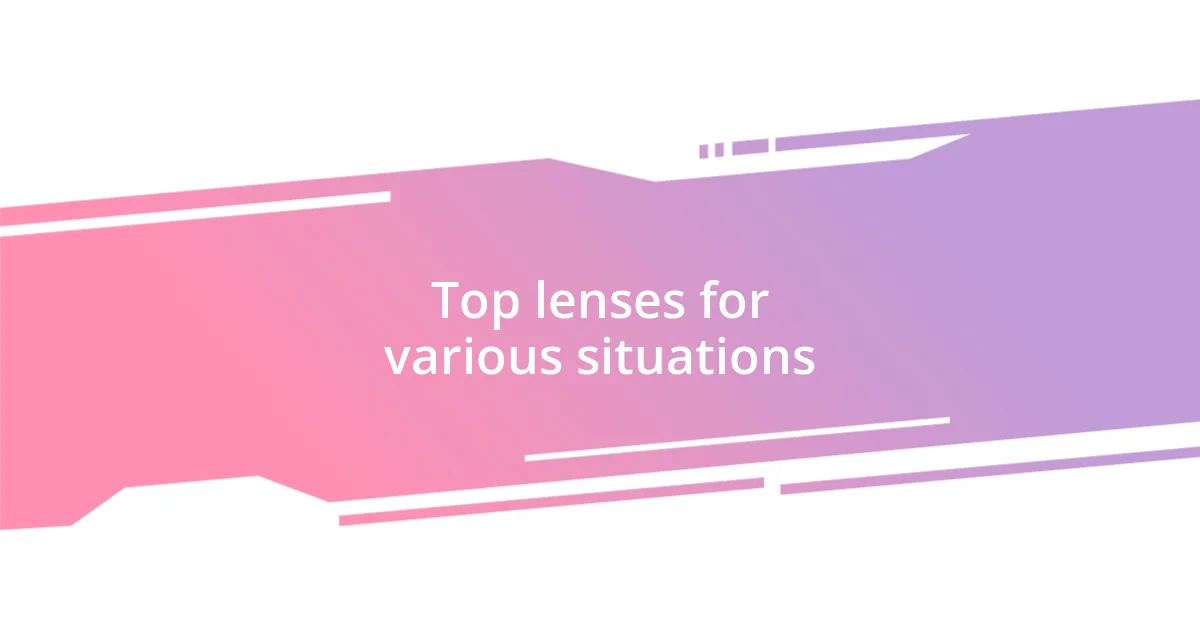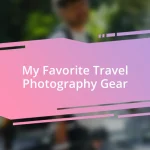Key takeaways:
- A lightweight mirrorless camera with versatile lenses is ideal for travel photography, enhancing spontaneity and convenience.
- Using the appropriate lenses for different situations (e.g., wide-angle for landscapes, telephoto for wildlife) significantly improves storytelling.
- Maintaining and organizing photography gear, along with utilizing effective editing tools, ensures high-quality results and memorable keepsakes from travel experiences.

Essential gear for travel photography
When it comes to essential gear for travel photography, a lightweight camera with a versatile lens is non-negotiable. I remember lugging around my bulky DSLR on a hike in the Swiss Alps, only to realize that my compact mirrorless camera would have captured those breathtaking views just as brilliantly—without the backache. Isn’t it amazing how much easier a smaller setup can make your experience, especially when you’re trying to capture the spontaneity of a beautiful sunset?
Don’t overlook the importance of a sturdy tripod, either. I once set up my tripod on a remote beach in Bali, hoping to shoot the stars twinkling above the waves. The stability allowed me to take long-exposure shots, which turned out to be some of my favorite memories from that trip. Have you ever tried night photography? It’s an entirely different world when you have a solid base to work from.
Lastly, consider investing in extra batteries and memory cards. Nothing stings quite like running out of juice just as you’re about to capture that perfect candid moment. During a spectacular sunrise in the Serengeti, I had two backups on hand but still felt the exhilarating rush knowing I was prepared. How do you ensure you’re ready when the magic happens? It’s all about being proactive with your gear!

Best camera for travel photography
For travel photography, I often find that a mirrorless camera strikes the perfect balance between quality and portability. On a recent trip to Kyoto, I appreciated how my lightweight setup allowed me to wander the narrow streets and capture the delicate cherry blossoms without feeling weighed down. And trust me, having the ability to swap lenses on the go made a significant difference when I wanted to zoom in on a hidden temple.
Here are some top choices I recommend for travel photography:
- Sony Alpha a6400: Compact and versatile, with fast autofocus—perfect for capturing fleeting moments.
- Fujifilm X-T30: Its retro design and color profiles produce stunning images that feel artistic.
- Canon EOS M50 Mark II: Offers great video capabilities and user-friendly controls, ideal for beginners.
- Olympus OM-D E-M10 Mark III: Lightweight with in-body stabilization, which is a lifesaver for handheld shots.
- Panasonic Lumix GH5: A great option for hybrid shooters focusing on both stills and video in various settings.
When I’m traveling, I often seek out the unexpected. Once while exploring the bustling markets in Marrakech, I found myself enamored with the vibrant colors and dynamic energy. My camera was crucial as it allowed me to capture candid shots of locals and the lively atmosphere—frozen memories of moments that would otherwise slip away. Isn’t it remarkable how the right gear enables you to tell a story through your photos?

Top lenses for various situations
When it comes to selecting lenses for travel photography, I’ve learned that matching the lens to the situation can enhance your storytelling. For wide landscapes, a good wide-angle lens can really capture the vastness and beauty of a scene like the towering cliffs of the Amalfi Coast. I remember gazing out over that stunning vista, my 16-35mm lens allowing me to snap every detail, from the cascading towns to the endless ocean. Don’t you just love the way a lens can transform your perspective?
In wildlife situations, a telephoto lens becomes your best friend. During a safari in South Africa, my 70-200mm lens proved invaluable as I carefully observed a pride of lions from a safe distance. The ability to zoom in for those intimate expressions made the experience incredibly memorable. There’s something about capturing a raw, candid moment in nature that just makes your heart skip a beat, doesn’t it?
For low-light environments like bustling city scenes at night, a fast prime lens is essential. I recall walking through the neon-lit streets of Tokyo, armed with my 50mm f/1.8 lens. It performed beautifully, allowing me to take sharp shots with gorgeous bokeh, even when the light was fading. It’s those moments, captured with clarity, that add depth to my travel stories.
| Situation | Recommended Lens |
|---|---|
| Landscape | 16-35mm Wide Angle |
| Wildlife | 70-200mm Telephoto |
| Low Light/Street Photography | 50mm f/1.8 Prime |

Must-have accessories for photographers
When it comes to essential accessories, a sturdy tripod is at the top of my list. Just think about it: capturing those breathtaking sunset shots or long-exposure nightscapes becomes a breeze with the right support. I remember setting up my tripod at the Golden Gate Bridge, watching as the sky transformed into a canvas of vibrant colors. It was a moment where stability equaled creativity, allowing me to explore unique perspectives without worrying about shaky hands.
Another accessory I can’t travel without is a reliable lens cleaning kit. Dust and smudges can sneak onto your lens, especially with all the movement while traveling. Once, while photographing the beautiful beaches of Thailand, I felt that sinking heart moment when I noticed a fingerprint on my lens. Thankfully, my cleaning kit was handy and saved the day, letting me capture those crystal-clear shots of the turquoise waters. Isn’t it comforting to know there’s a simple solution to avoid frustration in the field?
Lastly, a comfortable camera strap is something many photographers overlook, but it made a huge difference during my explorations. I recall hiking through the lush landscapes of New Zealand, and my padded strap felt like a lifesaver as I clambered over rocky paths. The support it offered let me focus on the breathtaking views instead of soreness. Have you ever thought how little things can have such a big impact on your experience? A good strap not only enhances comfort but also keeps your gear secure as you move about.

Tips for packing photography gear
Packing photography gear can feel like an art in itself. I usually take a moment to lay everything out before stuffing it into my bag. This way, I can visualize what I’ll need based on my itinerary, ensuring that I don’t overlook any essentials. Have you ever packed hastily only to realize later that you forgot a crucial lens? Trust me, it’s a sinking feeling that I’ve experienced more times than I’d like to admit.
When I travel, I prioritize using a well-padded, compartmentalized backpack. It not only protects my gear but also helps me stay organized. I remember a trip to Iceland when I had to navigate through snow and ice-covered trails, and my backpack kept everything secure. Having easy access to my camera gear while on the move was a game changer. Isn’t it reassuring to know that a good bag can literally save your day, especially in unpredictable environments?
I also recommend using lens caps and body caps religiously. They might seem trivial, but I learned this the hard way during a beach shoot in Bali. Without those caps, sand found its way into my camera, creating nightmares during my editing process back home. Since then, they’ve become a non-negotiable part of my packing routine. Sometimes, it’s the little things that make the biggest difference, don’t you think?

Maintaining gear on the road
If you’re on the road, maintaining your photography gear can sometimes seem like a daunting task, especially when you’re surrounded by breathtaking scenes demanding your attention. I vividly recall one morning in the Swiss Alps, when a sharp drop in temperature caused condensation to form on my camera. It was a nerve-wracking moment, but I had learned to keep my gear at room temperature before heading out. This simple strategy prevented any damage and let me focus on capturing the stunning landscape instead of worrying about potential equipment failure.
Regularly checking your equipment during your travels is crucial, too. I always take a moment to inspect my camera and lenses for any signs of wear or damage, especially after a long day of shooting. One time, while trudging through the bustling streets of Tokyo, I noticed a loose lens mount after switching lenses several times. Thankfully, I had a toolkit with me, and tightening that screw not only saved my session but also reminded me of the importance of being mindful of my gear’s condition. Have you ever found yourself in a similar situation, where a quick check could have prevented a mishap?
When it comes to cleaning your gear on the road, it’s essential to develop a routine. I’ve made it a habit to clean my camera sensor and lenses every few days, especially after shooting in dusty or humid environments, like when I traveled through the deserts of Jordan. On one occasion, I neglected this practice and ended up with spots on my images that were a hassle to edit later. It was a valuable lesson that keeping a small blower and microfiber cloth on hand can ensure the equipment stays in pristine condition—ultimately saving time in post-processing and enhancing the quality of my work.

Editing tools for travel photos
Editing tools play a vital role in transforming travel photos into memorable keepsakes. I’ve fallen in love with Adobe Lightroom for its user-friendly interface and powerful features. Once, while sifting through hundreds of photos from a stunning sunset in Santorini, Lightroom made it effortless to enhance colors and adjust exposure, instantly bringing that magical moment back to life. Don’t you just love when an editing tool can evoke the emotions you felt in that moment?
Another tool I often turn to is Snapseed. This mobile editing app is perfect for on-the-go tweaks, especially when I’m impatient to share my memories right away. I remember editing a street photo in bustling Marrakech while sipping mint tea at a local café. The ability to apply selective edits and filters helped me highlight vibrant colors, and I felt a rush of satisfaction when my followers commented on the new life I breathed into the image. Have you ever felt that thrill of sharing a photo that resonates so deeply with your audience?
For those who prefer more advanced editing, Photoshop is an absolute powerhouse. I still recall tackling my very first complex edits—removing distractions from a stunning mountain landscape I captured in Patagonia. At first, it felt overwhelming, but as I learned to use tools like the clone stamp and layer masks, the potential seemed limitless. It’s rewarding to see how these tools can turn good photos into extraordinary pieces. What’s beautiful is how experimenting with these tools allows me to grow as a photographer. What about you? Which editing tools have transformed your photography?












